Latest News
June 1, 2012
By Pamela J. Waterman
Makerbot, PrintrBot, Fab@Home and more—where does one begin in the universe of personal 3D printer (P3DP) choices? Given the exponentially growing number of additive manufacturing (AM) systems targeted directly to consumers, you definitely have a few decisions to make.
Established systems and crowd-funded start-ups now number in the dozens, and are getting more exciting by the week. From total-do-it-yourself to assembled-but-needing-attention to almost-completely-out-of-the-box, the variety of choices dictates you do your homework. DE gives you questions to consider and resources to read or view for sorting out the best fit for your interests, skills and budget.
Getting Started
P3DPs are the man-in-the-street response to commercial AM systems (See “Additive Manufacturing 101,” DE, November 2010) whose prices have, until recently, started above $20,000 and often run to $100,000 and more. Emerging from both university-based and individual efforts, the P3DP movement began in 2004 with the open-source RepRap Project at the University of Bath, England.
Invented by engineer and mathematician Adrian Bowyer, RepRap stands for Replicating Rapid-prototyper, a Tinker Toy-looking structure that builds parts layer by layer by extruding melted plastic filament such as acrylonitrile butadiene styrene (ABS) and biodegradable polylactic acid (PLA). (This approach is often compared to Fused Deposition Modeling, or FDM, the approach Stratasys invented in 1989.) In addition to its simplicity, the radical aspect of a Rep Rap system is that its software, documentation and designs are distributed at no cost under the open-source GNU General Public License. Further, a driving philosophy and primary feature is that the system can build 50% of the parts needed to build another identical system—thus, the term replicating.
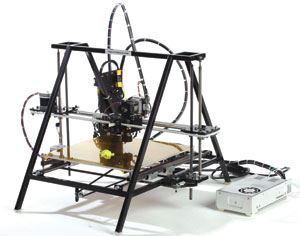 Glacier Steel, a sturdy, steel-frame RepRap printer from The Future is 3D. Image courtesy The Future is 3D. |
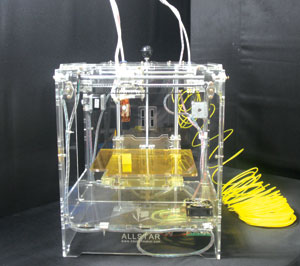 The Cannonball Allstar from iPrint Technologies is a RepRap-based 3D printer, available assembled or in a kit. Image courtesy iPrint Technologies. |
Dozens of companies have since sprung up that sell RepRap part kits and fully assembled models. In addition, in 2006, a new evolutionary branch of the P3DP concept began with the introduction of the Fab@Home system. Developed by Hod Lipson and Evan Malone of the Cornell University Computational Synthesis Laboratory, the Fab@Home project replaces the filament and nozzle of RepRap with a syringe feeder for material placement. This latter design allows the use of any semi-solid material of a consistency that will feed through the syringe—supporting 3D printing in silicone, cement, frosting, chocolate and more.
This fast-paced subculture has already created multiple printer generations, and inspired dozens of straight-talking blogs, forums and user groups. Some online communities focus on a single brand, while others discuss and compare systems, software, materials and the personal-printing universe in general. To ensure a good fit, minimize frustration and get totally psyched, you could, and should, spend hours learning from these experienced users.
What’s Your Type?
Where do your interests lie?
- Does opening a box filled with nuts, bolts, rods, plates, motors and gears just make your day? Do you push the operational limits of every piece of hardware that comes your way? Is there anything in your shop that you haven’t modified in some way to improve its performance? Then you’re the classic kit customer, well suited to the assembly, calibration, repair and tweaking often required to get the most from your system. Kits start at $549 (PrintrBot).
- Are you a hands-on person with a streak of geekiness who doesn’t mind fine-tuning a device to make it work its best? Do you want to spend more time designing and printing objects than dealing with the printer itself? Then you’ll probably be happiest buying a fully assembled model from a company that provides strong online support. Just announced, the assembled RepRap-style Solidoodle starts at $499.
- Have you been waiting for a P3DP that eliminates the whole wires-and-struts look and might have more in common with your coffeemaker? Even you can join the P3DP revolution, though currently you’ll pay more for the opportunity. Bridging the office-desktop and kitchen-counter, these more productized systems range from $1,299 to $19,900, but can create pieces with quality rivaling those from production AM equipment. (3D Systems has made quite a splash entering this market with its new Cubify Cube.)
You’ll find many details to keep in mind as you compare systems, so don’t choose by price alone. Basic differentiators are build envelope (the cubic dimensions of the largest part you can build), part smoothness (mostly affected by layer thickness and build speed, which can vary greatly), and available materials. Most systems are driven by computer (PC vs. Mac), but some read files directly from an SD card. Verify whether all electronics—and possibly a heated build-platform—are included.
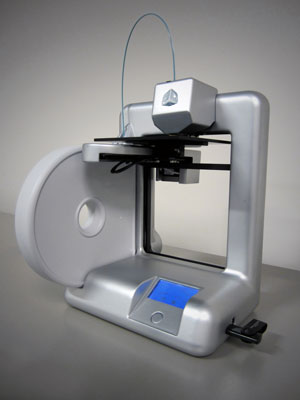 The 3D Systems Cube 3D printer creates parts from a filament of ABS plastic, available in many colors. Image courtesy 3D Systems/Cubify. |
 The ABS filament Up! V1.1s printer; the extruder moves in the x-axis only, while the build platform moves in the y and z directions. Image courtesy Delta Micro Factory. |
Think, too, about multiple-color (dual/triple head) printing, delivery cost, lead time and whether you care if your system can use any supplier’s materials (you could be locked into those sold only by the system manufacturer).
Dozens of RepRap Choices
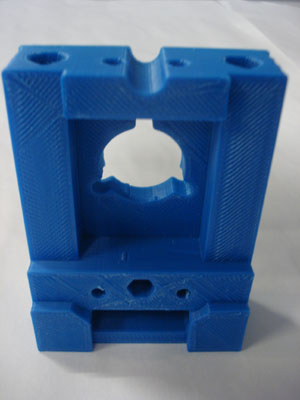 ABS plastic part created on a BotMill (RepRap style) system. Image courtesy BotMill. |
RepRap.org offers instructions for building its Prusa Mendel, MendelMax, Wallace, Original Mendel and RepRapPro Huxley models. A number of companies sell kits and/or assembled units based on these designs; representative models with build volumes and pricing are as follows (see company websites for additional models and specifications):
- BitsfromBytes (a 3D Systems company): RapMan 3.2 (270x205x210mm, kit $1,390); 3DTouch (275x275x210mm, assembled, single-head version $3,490).
- BotMill (a 3D Systems company): Axis (200x200x140mm, kit $1,065), Glider (same, assembled $1,395).
- Buildatron: Buildatron 2 (200x200x140mm, kit $1,599; assembled $2,500). You can send Buildatron pictures of problem builds, and the company will help diagnose what went wrong and how to fix it.
- Delta Micro Factory: UP! v1.1s (140x140x135mm, assembled $1,499); Up! Mini (enclosed structure, just going into production, 120x120x120mm, assembled $899). Extruder moves in x-axis only, while platform moves in y and z directions.
- The Future is 3-D Inc.: The company builds RepRaps for you, no money down. Mendel Basic comes in three sizes: smallest build 300x300x240mm, assembled $2,100; largest build 406x406x292mm, assembled, $2,300. Glacier Steel, with one-piece-metal construction, has a largest build of 406x406x445mm, assembled, $2,800.
- iPrint Technologies: Prusa Explorer (200x200x100mm, DIY kit, $595; semi-assembled, $795, assembled, $995); Cannonball Allstar (200x200x120mm, DIY kit, $1,195; assembled, $1,595).
- Leapfrog: Creatr (hobbyist, 300x250x260mm, assembled $1,635); Xeed (business, 370x340x290mm, assembled $6,438); robust laser-cut aluminum housing.
- Makerbot Industries: Thing-O-Matic (listed here for completeness, but no longer available); Replicator (225x145x150mm, assembled single head $1,749); Dualstrusion ($1,999).
- MakerGear: Mosaic, for people primarily interested in printing (127x127x127mm, kit $899; assembled $1,299); Prusa Mendel, for the true build/mod/maintain user (203x203x203mm, kit $825).
- Mauk Custom Creations: Cartesio M(edium) VO.5, a desktop computer numerical control (CNC) machine with a 3D print extruder (200x200x200mm, kit $2,256).
- PrintrBot: funded through Kickstarter.com, just started shipping kits in March (152x152x152mm, kit $549).
- Robot Factory: 3D ONE (245x245x245mm, assembled $3,926).
- Solidoodle: Solidoodle 3D printer (152x152x152mm; assembled $499 Base Model; Pro Model with heated platform, $549).
- SUMPOD: SUMPOD BIG (300x250x150mm, kit $718); SD card-reader included.
- Ultimaking: Ultimaker, described as having very simple electronics (210x210x220mm, kit $1,562).
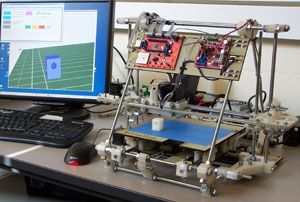 An example of a classic, open-source RepRap Mendel 3D printer. Image courtesy RepRap. |
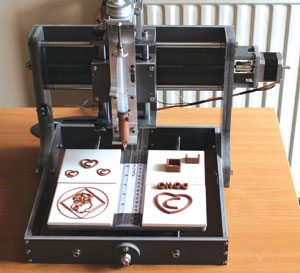 Choc Edge 3D edible chocolate printer (Fab@Home style) system, showing extruder syringe dispensing melted chocolate. Image courtesy Choc Edge. |
The World of Fab@Home
The Fab@Home project includes hundreds of engineers, inventors, artists, students and hobbyists across six continents—all with broad production goals ranging from food to toys to replacement parts to buildings. Its roots were in the design of a robot that could “evolve” by reprogramming itself and producing its own hardware; the project quickly became much broader. One of its key elements is the openness to use multiple materials, such as edible ingredients or a two-part epoxy.
Compared to RepRap designs, Fab@Home systems are still much more DIY projects, with numerous parts suppliers listed on the project’s website. The original Fab@Home Model 1 has a build volume of 203x203x203mm; Model 2 has the same build volume, but has been redesigned to perform better and be easier to assemble, particularly with respect to the electronics.
- Essential Dynamics: Imagine 3D Printer (203x203x203mm, assembled $2,995).
- The Next Fab Store: Fab@Home v1 (203x203x203mm, kit $1,950; assembled, single syringe $3,300); v2 (203x203x203mm, kit, single syringe $2,125; double syringe $2,500)
More Recent P3DP Activity
There seems to have been an explosion this past year in the P3DP development field. 3D Systems’ new Cubify Cube certainly elevates the legitimacy of this market. The sleek, fully assembled ABS-filament-fed unit features a build volume of 140x140x140mm and was specifically designed for home use. It employs USB and Wi-Fi connectivity and costs $1,299.
Many more systems are in the works, including those launching via the new wave of crowd-funding online communities such as Kickstarter, Indiegogo and Makible. An extremely hot topic is the development of a personal, high-resolution ultraviolet (UV)-cure-resin printer; several are for sale, while some are just at the prototype stage:
- Veloso: high-resolution 3D printer based on TI’s digital light processing (DLP) projector and liquid photopolymers; Indiegogo crowd-funded (150x112x200mm, Basic Kit I without projector, motors or linear guides, $599; Basic Kit II without projector, $1,999; Full Kit $3,999).
- MiiCraft: DLP pico-projector-based system with open-source software (43x27x180mm, kit with projector approximately $2,000).
- LemonCurry: UV photopolymer DLP 3D printer; Google open-source project.
- ScribbleJ on Thingiverse: DLP-based resin printer (prototype, used parts purchased for less than $200).
- Vienna University of Technology: LED-cured resin (“milk-carton sized,” possibly $1,570).
Building on the RepRap design:
- Makibox: Makible crowd-funded (kit listed at $350).
- Maxifab: 3D Printing Framework (203x203x203mm, looking for funding on Kickstarter).
- SUMPOD: Aluminum Small (120x120x100mm, assembled $653, Indiegogo pricing).
New in the Fab@Home world is the Choc Creator chocolate extrusion-printing machine from Choc Edge (175x175x70mm, assembled $3,256). In addition, a P3DP based on sintering powders is under development: Check out BluePrinter ApS’ selective heat sintering (SHS) thermal print-head printer for plastics (160x200x140mm, assembled $13,079).
Space constraints limit this discussion to the basics. Depending on your needs, you may want to put in the required web research hours to learn more about the many P3DP and hobbyist offerings online.
However, if you’re looking for more professional 3D printing options that still won’t break the bank for a small- or medium-sized company, see rapidreadytech.com.
Contributing Editor Pamela Waterman, DE’s simulation expert, is an electrical engineer and freelance technical writer based in Arizona. You can send her e-mail to [email protected].
MORE INFO
BitsfromBytes
BluePrinter
BotMill
Buildatron
Choc Edge
Cubify
Delta Micro Factory
Essential Dynamics
Fab@Home
The Future is 3-D
iPrint Technologies
Leapfrog
LemonCurry
Makerbot Industries
MakerGear
Makibox
Maxifab 3D Printing Framework
Mauk Custom Creations
Miicraft
The NextFab Store
PrintrBot
Rapid Ready Tech
RepRap
Robot Factory
Solidoodle
SIMPOD
Thingiverse
Ultimaking
Veloso
Vienna University of Technology
Subscribe to our FREE magazine, FREE email newsletters or both!
Latest News
About the Author
Pamela Waterman worked as Digital Engineering’s contributing editor for two decades. Contact her via .(JavaScript must be enabled to view this email address).
Follow DE





